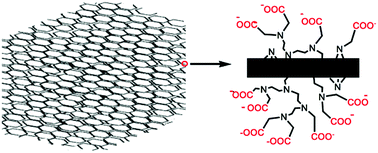Macrosurfactant-mediated, aminopolycarboxy-acid-decorated open-cellular adsorbent for removing metal micropollutants from water
Abstract
Aminopolycarboxy acids (APAs) are well known for their ultrastong affinity for heavy metals. Their monolayer, full-coverage, robust and one-step decoration of the surface of a macroporous adsorbent has not yet been realized. In the current work, we derived a cost-effective strategy to produce a porous adsorbent with the aid of a dendritic macrosurfactant. Branched polyethylenimine (PEI) was partly alkylated with glycidyl cetylether (C16) to form a dendritic polyamine macrosurfactant (PEI@C16, Mn ∼ 104). This macrosurfactant well stabilized a water-in-oil high internal phase emulsion (HIPE), while a macrosurfactant counterpart based on linear PEI did so poorly. Heating the HIPE system triggered a simultaneous transformation of the residual amines of PEI@C16 into APAs and of the oil phase (consisting of styrene, divinylbenzene and radical initiator) into an open-cellular solid matrix. The resulting open-cellular monolith showed a rather large specific surface area and very high affinity for various heavy metal ions in water. The adsorption of Pb(II) was indicated to follow a chemical and monolayer adsorption mechanism. The adsorbent showed good recyclability, due to the robustly anchored APAs.



 Please wait while we load your content...
Please wait while we load your content...